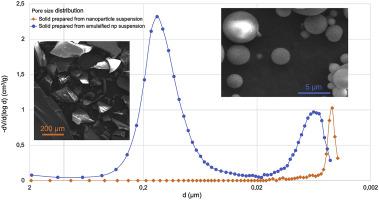Microporous and Mesoporous Materials ( IF 4.8 ) Pub Date : 2020-06-02 , DOI: 10.1016/j.micromeso.2020.110362 Mathieu Nespoulous , Mickaël Antoni , Carine Chassigneux , Renaud Denoyel

|
It is shown that porous spherical particles can be obtained via the freezing of silica nanoparticle aqueous suspensions emulsified in a continuous oil phase. After two freeze-thaw cycles, nanoparticles turn aggregated into flocculated objects with microstructure that depends upon emulsion volume fraction and droplet size. For low volume fractions, regular microspheres are produced while for large ones, irregular beads with several tens of micrometer radius are formed. Electronic microscopy, mercury porosimetry and nitrogen adsorption are used to get insights into these porous particles typical radius, pore size distribution, surface area and pore network structure. All exhibit mesopores that result from inter-nanoparticle spacing after flocculation. An unexpected macroporous domain appears which is not observed when drying non-emulsified suspensions. This macroporosity is interpreted as the signature of dendrite formation during the undercooled period, right before freezing occurs. Beside this additional macroporosity, the protocols presented in this article constitute also promising emulsion-based routes for porous material synthesis with original geometry, chemical composition and porosity.
中文翻译:

纳米流体乳液冷冻制得的多孔二氧化硅珠
结果表明,可以通过冷冻在连续油相中乳化的二氧化硅纳米颗粒水悬浮液来获得多孔球形颗粒。经过两个冻融循环后,纳米颗粒会聚集成絮凝的物体,其微观结构取决于乳液的体积分数和液滴大小。对于小体积分数,会产生规则的微球,而对于大分数,会形成半径为几十微米的不规则珠。使用电子显微镜,水银孔隙率法和氮吸附来深入了解这些多孔颗粒的典型半径,孔径分布,表面积和孔网络结构。所有的均显示中孔,这是由于絮凝后纳米颗粒之间的间距而产生的。出现意外的大孔区域,当干燥未乳化的悬浮液时未观察到。这种大孔隙率被解释为在过冷期间,即在冻结发生之前,枝晶形成的特征。除了这种额外的大孔隙率外,本文介绍的协议还构成了具有前景的基于乳液的途径,用于具有原始几何形状,化学组成和孔隙率的多孔材料合成。











































 京公网安备 11010802027423号
京公网安备 11010802027423号